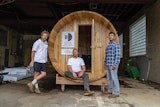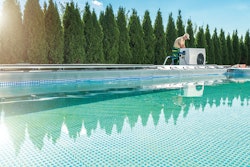Industry Memo:
Strippers in hot tubs are NOT considered a legitimate work-related expense.

Former Multi-CAP (MultiCommunity Action Against Poverty) director Paul R. Skaff Jr. really pushed the envelope, however, when he used his nonprofit agency's credit card to pay for a stripper to join him in a hot tub at a Charleston, W.V.-area strip club, according to an ongoing investigation.
The investigation turned up the strip club's order form, as well as Skaff's credit card statement, which show Skaff paid $250 twice for a stripper named Brittany to join him in a hot tub. Skaff apparently bought the stripper two drinks as well, at $20 a pop, during his early afternoon visit, and gave Brittany and the bartender, Jade, a $45 tip.
Skaff's attorney, Ben Bailey, has responded to the charge with an emphatic non-denial denial. "Not to our knowledge did that ever happen," he said.
Our take: Sure, Visa is everywhere you want to be. But sometimes it pays to pay cash.
Try the Rapidly Rising Sport of Finswimming
What is finswimming?
Finswimming is swimming like a seal or a dolphin, complete with one big dolphinlike flipper, instead of using the conventional (crawl stroke) paddle-wheel approach. You put on a special aerodynamic snorkel which snakes up over your forehead to the surface instead of curling around your neck. You put a huge, pliable monofin (a large single fiberglass or plastic blade) on your feet, stick your hands out in front of your head, and start undulating at the hips like Madonna, or Elvis, only much more slowly.
Once mastered, the method produces amazing acceleration through the water. This is partly due to the minimization of drag caused by the arms, which are held in an more aerodynamically efficient position.
In proper finswimming, the upper body remains still and the legs have minimal bend in the knees. Most of the movement comes from the hips and waist. Once this movement is mastered, according to enthusiasts, you can take Janet Evans in a sprint or over distance, take your pick.
Although swim fins have been around since the 1930s, the arrival of the monofin has completely transformed the sport of finswimming. Hitherto, finswimmers copied the traditional technique of the crawl. The arrival of the monofin, however, touched off a revolution. It first appeared in 1972 where swimmers were suddenly able to reach speeds of 7 mph.
Finswimming competitions have now been conducted for at least 30 years, involving swimmers from around the globe. In 1988 CMAS (Confederation Mondiale des Activities Subaquatiques - World Underwater Federation) applied to the International Olympic Committee to have finswimming accepted as an Olympic sport. In consideration of the growth that the sport is currently undergoing, the Hellenic Olympic Association has backed the bid to include the sport in the 2004 Olympics.
Wanted: A Few Good Players
U.S. tired of getting beat by world at odd sport
The annals of sport are filled with heartwarming stories of undersized and overmatched teams using sheer determination and heart to overcome their opponents. Who can forget the ragtag assemblage of college kids and rink rats that defeated the mighty Russian hockey team in the 1980 Winter Olympics? Or Joe Namath and his upstart New York Jets' stunning upset of the Baltimore Colts in the third Super Bowl?
In 1999 at the World Underwater Rugby Championships, a team of Americans were set to make history themselves by playing Davids to the world's Goliaths. With images of the cheering legions of fans, tickertape parades and lucrative endorsements that would surely follow when they crushed the fearsome Swedes, the team took to the water. After a great deal of splashing and thrashing, the team emerged from the pool, dripping and exhausted, where they were presented with the Sportsmanship Award (that's not a good thing).
"We didn't do so well," admits Arthur Davies, national director for the Underwater Rugby Society of America. "Other teams had government support and trainers and all that. We're just a bunch of guys that play. Hopefully in 2003 we'll have a bigger talent pool to draw from."
Davies is hoping to get the word out about the sport to encourage wider participation and increase competitiveness. It really isn't that hard to describe or understand, assuming you know something about rugby, but Americans know little about the land version of the sport much less the underwater version. Suffice to say the basic concept is to put the ball into a goal. It's kind of like soccer that way, only you use your hands instead of your feet. It's also a bit like football, only without huddles or John Madden.
The playing area is 30 to 40 feet wide and 40 to 60 feet long, with goals located 12 to 16 feet deep. The ball is filled with a salt solution to give it a negative buoyancy so it will sink. A team is made up of six players wearing masks, fins and snorkels. Choking, hitting and holding a player without the ball are forbidden, as is pulling on swimsuits. Otherwise, pretty much anything goes. To learn more about underwater rugby, or other underwater sports you didn't know existed, such as hockey or football, visit underwater-society.org.
Inside or Out
Inventive system makes portable spas mobile
Anyone who read AQUA's October issue featuring the 9th Annual Design Awards Competition came across a unique project submitted by Diversatech, Connellsville, Pa.
David Myers, owner of Diversatech, wanted to be able to use his hot tub outdoors when the weather cooperated and indoors when it didn't, so he relied on his experience with the company.
Diversatech manufactures rail systems for furnace cars used in steel mills. The furnace car follows this railing system into the furnace and the furnace doors close behind.
This same concept is used with his home hot tub.
A four-button, low-voltage switch control pad was installed on the hot tub to open and close the shelter door and move the tub forward or backward. No detail was missed, including safety. When the tub is in motion, a beeper sounds to alert anyone close by to move out of the way. It is also equipped with brakes. For homes that have small children, a safety lock switch is available for parents. Myers hopes the idea will take off nationwide.
"We're going to attempt to franchise across the country in different regions (regions with a similar climate to Pennsylvania's), says Myers. "During winter evenings, you will be able to have the privacy of your house, or drive it outside and enjoy the cool air with the warmth of the hot tub underneath the stars."
Spa Sanitizer Heads for Open Water
Technology used in tubs tested aboard oil tankers to combat bacteria
Scientists working to find ways to kill "hitchhiking" organisms on oil tankers are now testing a technology already used in sterilizing hot tubs.
Recent experiments aboard the oil tanker Tonsina, just off the coast of Anchorage, Alaska, could provide a major breakthrough in combating unmanageable ecological problems of today - the transport of bacteria from one coast to another in ballast water.
A prototype system, which mirrors conceptually an ozone hot tub purification system, was developed by Nutech O3, an ozone specialist company, and installed aboard Tonisa last year. The system uses 10,000 volts of electricity to produce four pounds of ozone per hour inside the ship. The ozone is then pumped through stainless-steel piping into the oil tanker's ballast tanks.
This process theoretically kills any plankton, bacteria or viruses in the ballast water.
Ballast water in ships has caused major biological problems around the world, in some cases causing extinction of wildlife. Two million gallons of ballast water is dumped each hour in U.S. ports.
BP began its experiment in the early 1990s after Roger Gale, former president of the company's shipping division, read that ozone is used to purify water in hot tubs.
Medicaid Must Buy Hot Tub, Court Rules
Finally, some support from the Feds
In a victory for the hot tub industry's effort to underscore the health benefits of hot tubs, the Colorado Court of Appeals has struck down a state regulation barring all hot tub purchases with Medicaid funds, saying the [imperious and narrow-minded] statute violates federal law.
In the future, Colorado Medicaid officials can't arbitrarily refuse to buy a hot tub for a patient whose doctor recommends the tub for arthritis. About half the funds used in Medicaid are provided by the federal government, the court said, so states must follow the federal rules.
In the case, a patient identified in court documents only as T.L., has a hereditary form of arthritis that causes him chronic hip pain. He also suffers from various fungal skin viruses because he is HIV-positive, court documents said.
T.L.'s doctor tried in 1999 to get Medicaid to pay for a hot tub for T.L.'s arthritis. State Medicaid officials refused. T.L. appealed, and an administrative law judge and then a state district judge sided with the state.
But the Court of Appeals said the state must individually evaluate each request for a hot tub or other "durable medical equipment" on the basis of medical necessity, following several specific criteria.
The plaintiff's lawyer, Joel Hayes, addressed the hot tub health benefit issue directly: "While many people think of a hot tub as a luxury, our client has a need for hydrotherapy because of his arthritis, and the HIV complications, which are pretty severe, make it impossible for him to use any kind of public facility for that therapy," said Hayes.
Of the ruling, Hayes said, "It's good news. It gives us a chance to prove that it's medically necessary, that it's costeffective and that it's supposed to be covered under federal and state Medicaid law."
Polly Want a Hot Tub
Parrot piques sales for dealer

Harmon, store manager of The Original Hot Tub Co., in Knoxville, Tenn., helped her employer stand out, really by accident, with help of a parrot, whom some would argue is the real store manager.
"He has the run of the place," says Harmon of Toby, a yellow-naped Amazon parrot, well known for its ability to mimic human speech. "He loves people coming into the store. He'll greet them with a cheery 'hello.' When they leave, he'll give a big 'bye-bye.'"
After her husband passed away more than 20 years ago, Harmon became lonely and wanted some company. She walked into a pet shop to buy some finches.
She then heard a voice say 'hello.' After walking some more toward the back of the store, she heard, "I love you."
It was Toby. Harmon said she immediately wheeled around, paid $1,650 for Toby and brought him home. Ever since then, Toby has kept a residency in the hot tub store, and it has paid dividends for both Harmon and the business.
Over the years, Toby has gained celebrity status, landing airtime on local television and gracing the pages of newspapers and magazines. This publicity has kept a steady stream of shoppers coming into the store, many of who, according to Harmon, would have never considered shopping at a hot tub store before discovering Toby. "People come in because they simply want to talk to the bird," says Harmon. "Then they come back because they want to visit the bird and they feel they have to buy something. I tell them they don't have to because Toby enjoys the company, but they still buy."
However, Toby won't talk to just any customer. According to Harmon, he prefers women. "Years ago a group of young boys tried to teach Toby to curse - since that day, he won't talk to men," Harmon explains. "When women come in, he will go through a lot of different things, especially singing songs. I have a customer who's a violinist with the local symphony. When Toby sees that customer, he starts singing musical scales. I don't know how Toby knows, but it just thrills the customer to death."











































